
The Rogue Song is a 1930 American pre-Code romantic and musical film that tells the story of a Russian bandit who falls in love with a princess, but takes his revenge on her when her brother rapes and kills his sister. The Metro-Goldwyn-Mayer production was directed by Lionel Barrymore and released in two versions, with and without sound. Hal Roach wrote and directed the Laurel and Hardy sequences and was not credited. The film stars Metropolitan Opera singer Lawrence Tibbett—who was nominated for an Academy Award for Best Actor for his performance—and Catherine Dale Owen. Laurel and Hardy were third-billed; their sequences were filmed at the last minute and interspersed throughout the film in an attempt to boost its potential box-office appeal.
This is a list of notable events in music that took place in the year 1930.

Jeanette Anna MacDonald was an American singer and actress best remembered for her musical films of the 1930s with Maurice Chevalier and Nelson Eddy. During the 1930s and 1940s she starred in 29 feature films, four nominated for Best Picture Oscars, and recorded extensively, earning three gold records. She later appeared in opera, concerts, radio, and television. MacDonald was one of the most influential sopranos of the 20th century, introducing opera to film-going audiences and inspiring a generation of singers.

King of Jazz is a 1930 American pre-Code color musical film starring Paul Whiteman and his orchestra. The film title refers to Whiteman's popular cultural appellation. At the time the film was made, "jazz", to the general public, meant jazz-influenced syncopated dance music heard on phonograph records, on radio broadcasts, and in dance halls. In the 1920s Whiteman signed and featured white jazz musicians including Joe Venuti and Eddie Lang, Bix Beiderbecke, Frank Trumbauer, and others.

Maytime is a 1937 American musical and romantic-drama film produced by MGM. It was directed by Robert Z. Leonard, and stars Jeanette MacDonald and Nelson Eddy. The screenplay was rewritten from the book for Sigmund Romberg's 1917 operetta Maytime by Rida Johnson Young, Romberg's librettist; however, only one musical number by Romberg was retained.
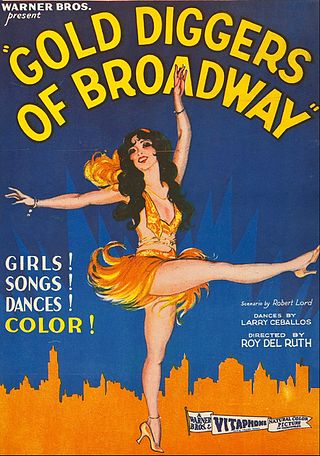
Gold Diggers of Broadway is a 1929 American pre-Code musical comedy film directed by Roy Del Ruth and starring Winnie Lightner and Nick Lucas. Distributed by Warner Bros., the film is the second all-talking, all-Technicolor feature-length film.
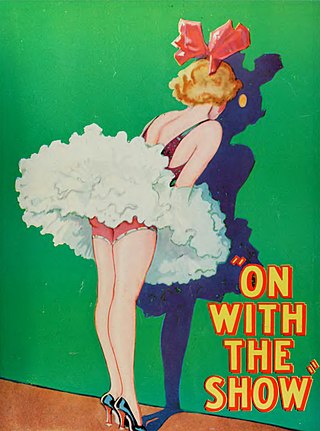
On with the Show! is a 1929 American pre-Code musical film produced by Warner Bros. Filmed in two-color Technicolor, the film became the first all-talking, all-color feature-length film, and the second color film released by Warner Bros.; the first was the partly color musical The Desert Song (1929).

The Show of Shows is a 1929 American pre-Code musical revue film directed by John G. Adolfi and distributed by Warner Bros. The all-talking Vitaphone production cost almost $800,000 and was shot almost entirely in Technicolor.

Song of the West is a 1930 American Pre-Code musical Western film produced by Warner Bros., and photographed entirely in Technicolor. It was based on the 1928 Broadway musical Rainbow by Vincent Youmans (music), Oscar Hammerstein II (lyrics) and Laurence Stallings (book). It starred John Boles, Joe E. Brown and Vivienne Segal, and was the first all-color all-talking feature to be filmed entirely outdoors.

Sally is a 1929 American Pre-Code film. It is the fourth all-sound, all-color feature film made, and it was photographed in the Technicolor process. It was the sixth feature film to contain color that had been released by Warner Bros.; the first five were The Desert Song (1929), On with the Show! (1929), Gold Diggers of Broadway (1929), Paris (1929) and The Show of Shows (1929).. Although exhibited in a few theaters in December 1929, Sally entered general release on January 12, 1930.
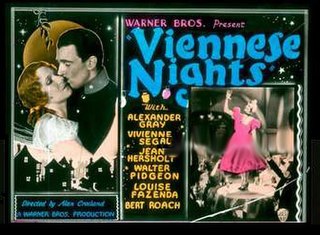
Viennese Nights is a 1930 American all-talking pre-Code musical operetta film directed by Alan Crosland and starring Alexander Gray, Vivienne Segal, Walter Pidgeon, Jean Hersholt, Bela Lugosi and Louise Fazenda. It was photographed entirely in Technicolor and released by Warner Brothers. Viennese Nights was the first original operetta written especially for the screen by Oscar Hammerstein II and Sigmund Romberg. It was filmed in March and April 1930, before anyone realized the extent of the economic hardships that would arrive with the Great Depression, which had begun in the autumn of the previous year. Although not a box office hit in the United States, the film had long box office runs in Britain and Australia. It is one of the earliest sound films to have a short pre-credit sequence.

Paris is a 1929 American pre-Code musical comedy film, featuring Irène Bordoni. It was filmed with Technicolor sequences: four of the film's ten reels were originally photographed in Technicolor.

The Vagabond King is a 1930 American Pre-Code musical operetta film photographed entirely in two-color Technicolor. The plot of the film was based on the 1925 operetta of the same name, which was based on the 1901 play If I Were King by Justin Huntly McCarthy. The play told the story of the real-life renegade French poet named François Villon. The music of the film was based on a 1925 operetta, also based on the play If I Were King by McCarthy. The operetta is also titled The Vagabond King with music by Rudolph Friml and lyrics by Brian Hooker and W.H. Post. The film was nominated for an Academy Award for Best Art Direction.
"Some Day" is a song, with music by Rudolf Friml and words by Brian Hooker, originally published in 1925. It was included in Friml's operetta The Vagabond King, sung by Carolyn Thomson in the role of Katherine de Vaucelles.

The Cat and the Fiddle is a 1934 American pre-Code romantic musical film directed by William K. Howard based on the hit 1931 Broadway musical of the same name by Jerome Kern and Otto A. Harbach, about a romance between a struggling composer and an American singer. The film stars Ramon Novarro and Jeanette MacDonald in her MGM debut.
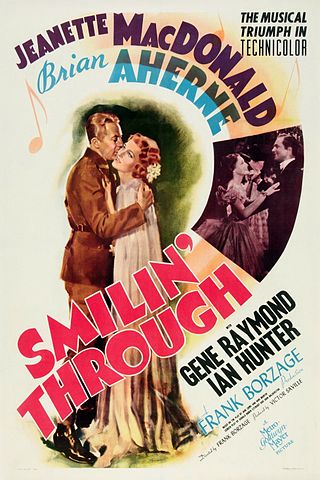
Smilin' Through is a 1941 American Technicolor musical film directed by Frank Borzage and starring Jeanette MacDonald, Brian Aherne, Gene Raymond and Ian Hunter. Produced by Metro-Goldwyn-Mayer, it is based on the 1919 play of the same name by Jane Cowl and Jane Murfin. The film was a remake of a previous 1932 version by MGM and was the third and final film version of the play. It was filmed in Technicolor and was remade as a musical for MacDonald with several older songs interpolated into the story.
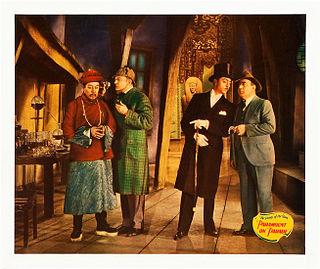
Paramount on Parade is a 1930 all-star American pre-Code revue released by Paramount Pictures, directed by several directors including Edmund Goulding, Dorothy Arzner, Ernst Lubitsch, Rowland V. Lee, A. Edward Sutherland, Lothar Mendes, Otto Brower, Edwin H. Knopf, Frank Tuttle, and Victor Schertzinger—all supervised by the production supervisor, singer, actress, and songwriter Elsie Janis.
Hal Roach's Streamliners are a series of featurette comedy films created by Hal Roach that are longer than a short subject and shorter than a feature film, not exceeding 50 minutes in length. Twenty of the 29 features that Roach produced for United Artists were in the streamliner format. They usually consisted of five 10-minute reels.

The following features lists of the film, television and stage performances of actress and singer Jeanette MacDonald. She is best remembered for her musical films of the 1930s with Maurice Chevalier and Nelson Eddy, but she starred in 29 feature films between 1929 and 1950, from operas to dramas to romantic comedies.















